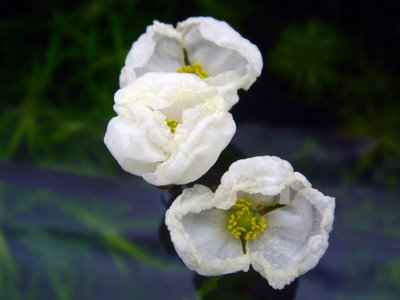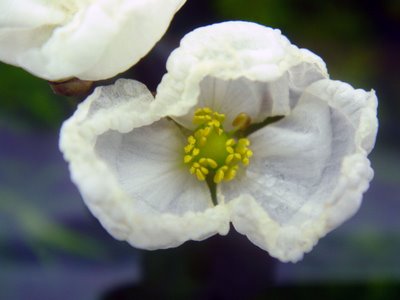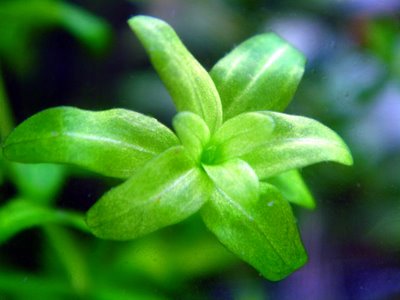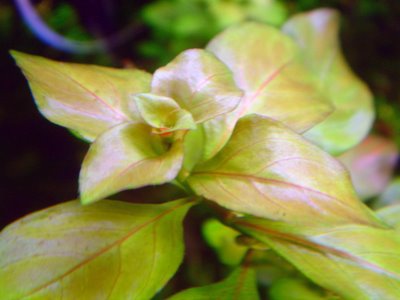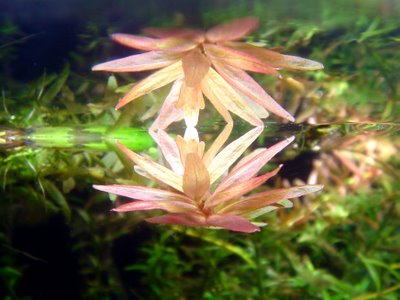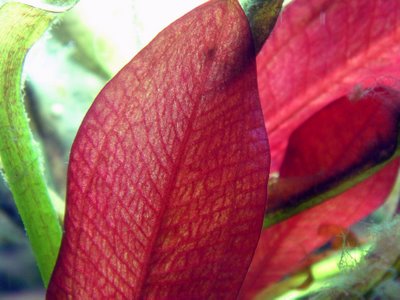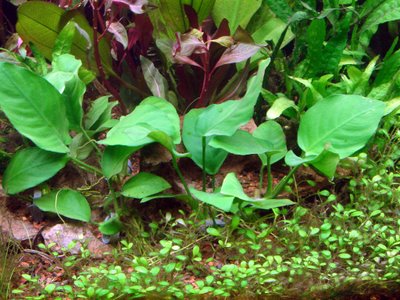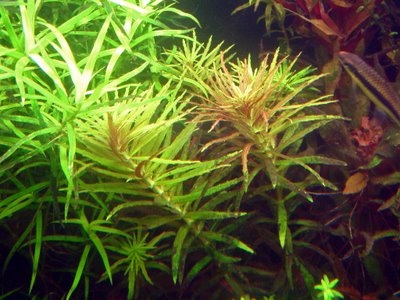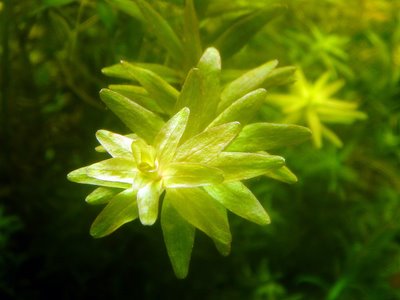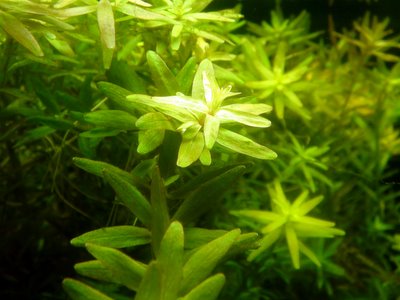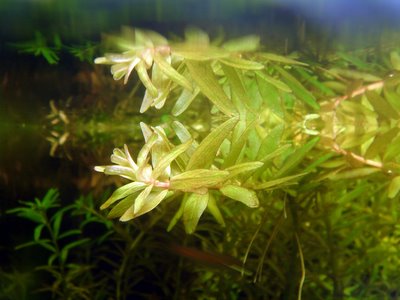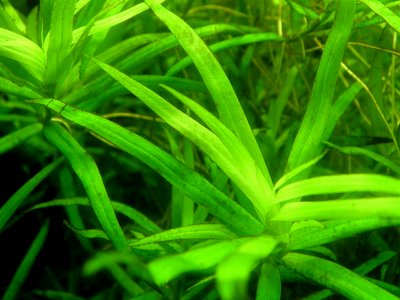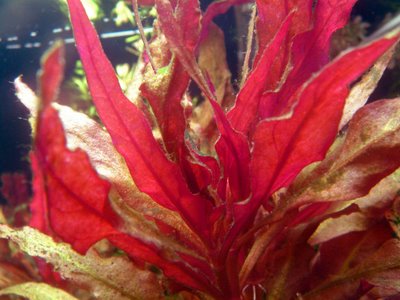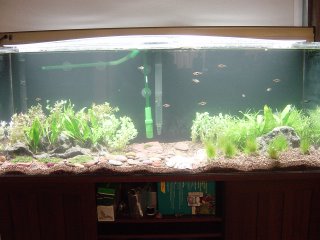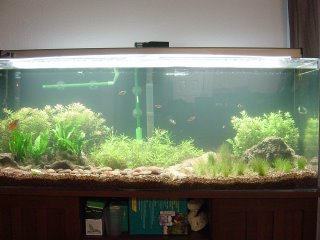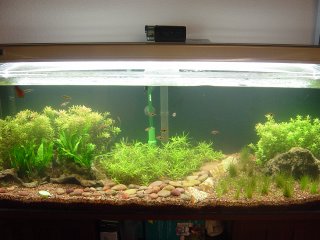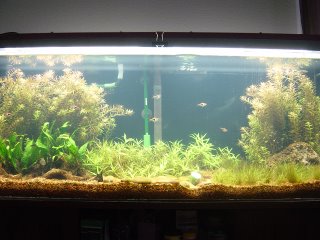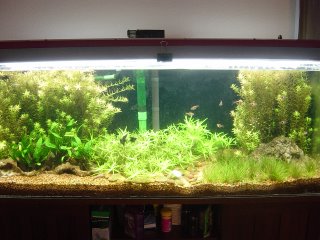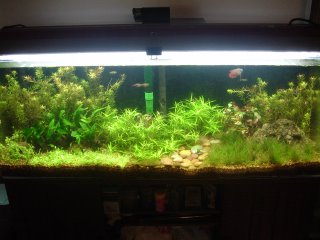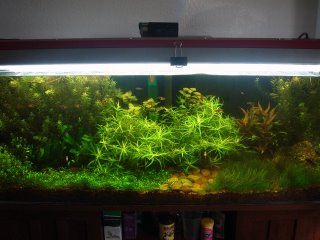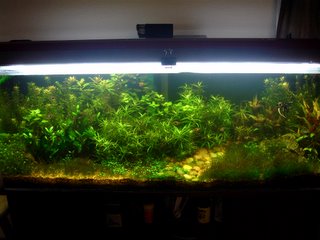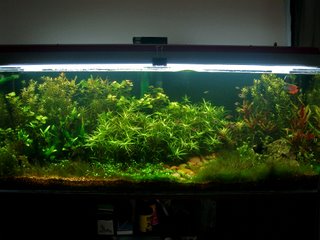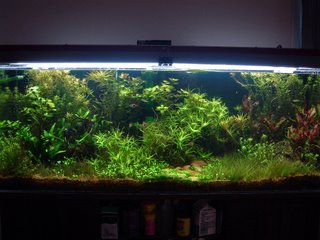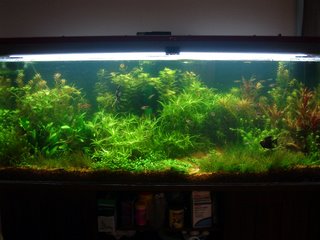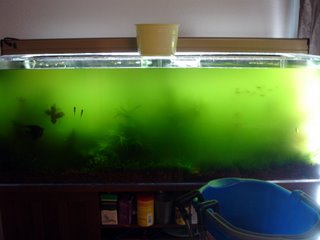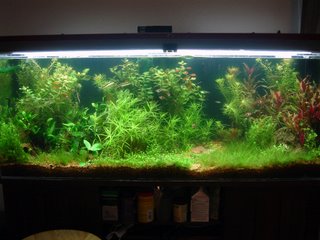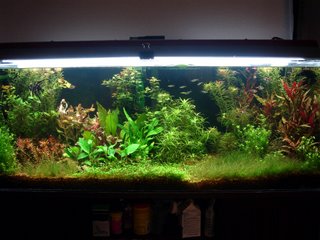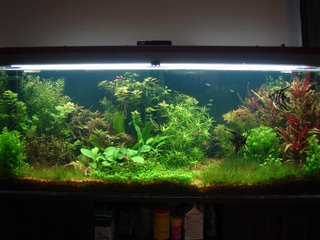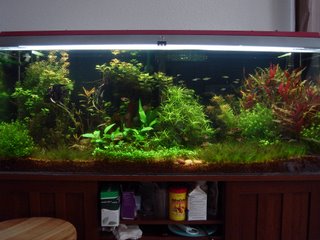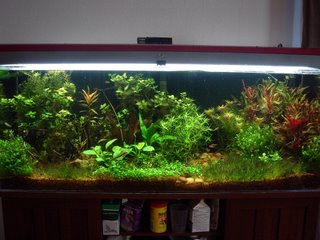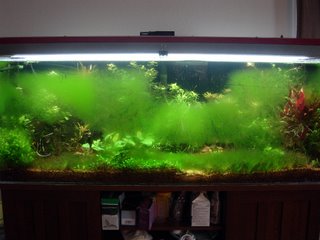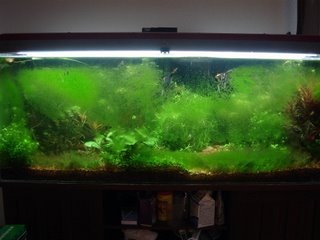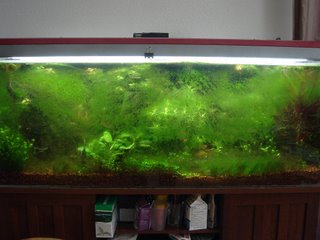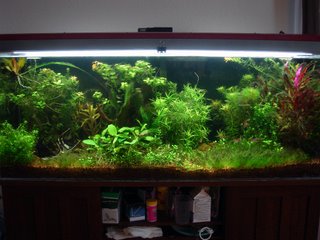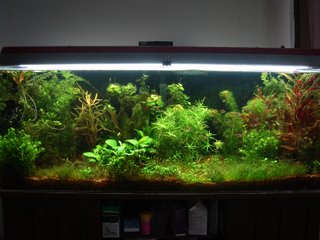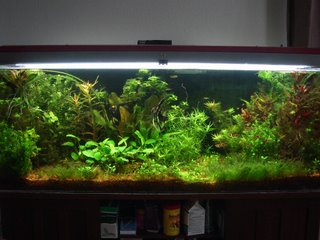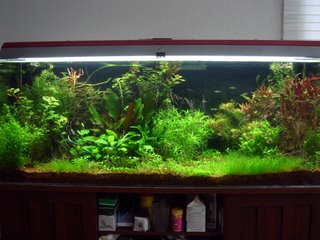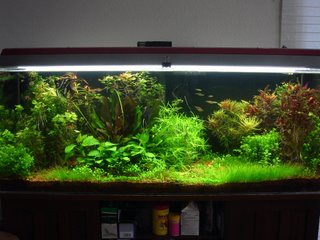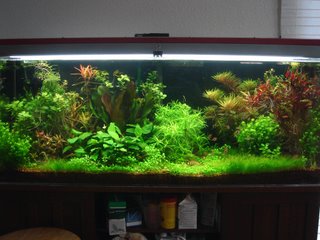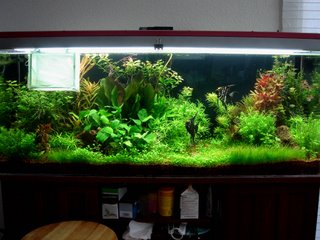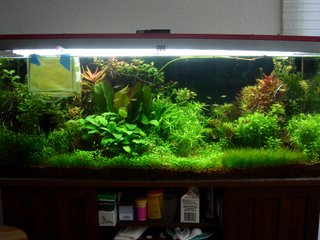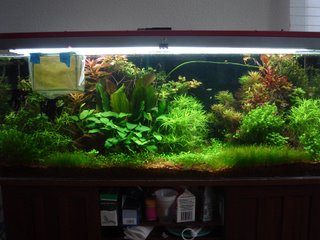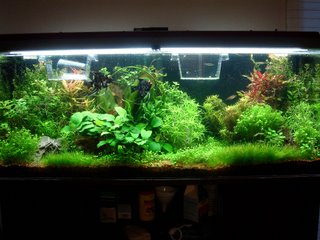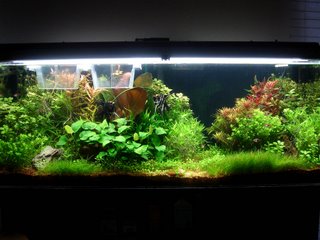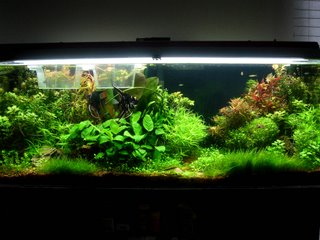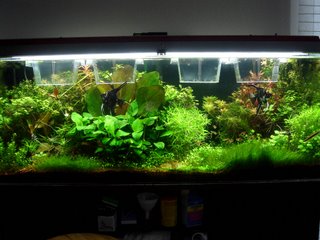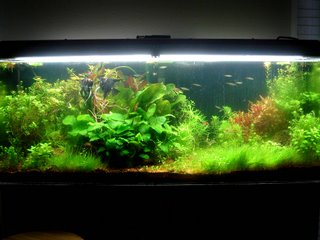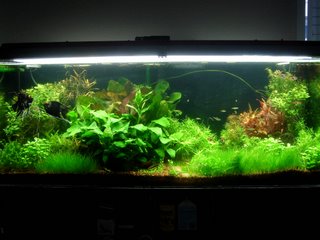- pH:
- Temp:
- KH:
- GH:
- NH4:
- NO2:
- NO3:
- PO4:
- Iron:
- Dosing: 10 mL Flourish, 20 mL iron chelate (2 ppm)
Sunday, February 26, 2006
Saturday, February 25, 2006
Ludwigia inclinata var. verticillata ("Cuba") and Limnophila hippuroides ("Gratiola")
- pH: 6.9
- Temp:
- KH: 5.5
- GH:
- NH4:
- NO2:
- NO3: 5-10 before dose
- PO4: 0.2 before dose
- Iron:
- Dosing:5 mL KNO3 (1.25 ppm), 20 mL KH2PO4 (0.8 ppm)
Notes:
50% water change:
20 mL Amquel+
2.5 tsp baking soda
6 tsp Equilibrium
I pruned the Rotala indica and the stargrass, and traded it in to a LFS for credit. I bought some Ludwigia inclinata var. verticillata ("Cuba") and Limnophila hippuroides ("Gratiola").
The stargrass has really benefitted from adding the nitrates/phosphates/iron/potassium, growing leaves that are double in size from when I originally received it. It seems that the stargrass needs a lot of potassium (>30 ppm per week) in order to prevent black patches from appearing on the leaves.
Friday, February 24, 2006
Solution Recipe Reference
50 gallons = 189.27 L
Iron Chelate Solution
8.5 tsp 10% iron chelate (Sprint 330, you can purchase this at www.amleo.com)
250 mL tap water
5 mL of this solution in 50 gallons water = 0.5 ppm iron
Nitrate Solution
(Assuming 5.6 g per tsp)
7 tsp KNO3 (purchase at www.gregwatson.com)
500 mL tap water
5 mL of this solution in 50 gallons water = 1.25 ppm NO3, 0.8 K
Phosphate Solution
(Assuming 4.8 g per tsp)
1.0 tsp KH2PO4 (purchase at www.gregwatson.com)
500 mL tap water
5 mL of this solution in 50 gallons water = 0.2 ppm PO4
Potassium Solution
(Assuming 6 g per tsp)
7 tsp K2SO4 (purchase at www.gregwatson.com)
500 mL tap water
5 mL of this solution in 50 gallons water = 1.0 ppm K
1 tsp dry = 14.23 ppm K
Equilibrium
(Assuming 5.33 g per tsp)
1 tsp in 50 gallons water = +0.4 dGH, 5.5 ppm K, 2.27 ppm Ca, 0.68 ppm Mg, 0.03 ppm Fe, 0.02 ppm Mn
Raising KH
1.1 tsp baking soda in 50 gallons water = +1 dKH
Raising GH
1 tsp Magnesium Sulfate x 7 H20 (epsom salts, assuming 5.4 g per tsp, 9.9% Mg) = +2.82 ppm
1 tsp Calcium Chloride x 2 H20 (assuming 3.6 g per tsp, ) = +5.2 ppm
1 tsp Calcium Sulfate x 2 H2O = +4.5 ppm
(Target Ca:Mg ratio of 3.35:1, similar to Equilibrium ratio)
GH in CaCO3 ppm = (2.5 * Ca in ppm) + (4.1 * Mg in ppm)
x = Ca ppm
y = Mg ppm
1 dGH = 17.9 ppm CaCO3
17.9 - (2.5 * x) = 4.1 y
y * 3.35 = x
17.9 - (2.5 * y * 3.35) = 4.1 y
17.9 - 8.375 y = 4.1 y
y = 1.435 ppm Mg
x = 4.807 ppm Ca
0.5 tsp Magnesium Sulfate x 7 H20 + 0.92 tsp Calcium Chloride x 2 H2O = approx +1 dGH
Iron Chelate Solution
8.5 tsp 10% iron chelate (Sprint 330, you can purchase this at www.amleo.com)
250 mL tap water
5 mL of this solution in 50 gallons water = 0.5 ppm iron
Nitrate Solution
(Assuming 5.6 g per tsp)
7 tsp KNO3 (purchase at www.gregwatson.com)
500 mL tap water
5 mL of this solution in 50 gallons water = 1.25 ppm NO3, 0.8 K
Phosphate Solution
(Assuming 4.8 g per tsp)
1.0 tsp KH2PO4 (purchase at www.gregwatson.com)
500 mL tap water
5 mL of this solution in 50 gallons water = 0.2 ppm PO4
Potassium Solution
(Assuming 6 g per tsp)
7 tsp K2SO4 (purchase at www.gregwatson.com)
500 mL tap water
5 mL of this solution in 50 gallons water = 1.0 ppm K
1 tsp dry = 14.23 ppm K
Equilibrium
(Assuming 5.33 g per tsp)
1 tsp in 50 gallons water = +0.4 dGH, 5.5 ppm K, 2.27 ppm Ca, 0.68 ppm Mg, 0.03 ppm Fe, 0.02 ppm Mn
Raising KH
1.1 tsp baking soda in 50 gallons water = +1 dKH
Raising GH
1 tsp Magnesium Sulfate x 7 H20 (epsom salts, assuming 5.4 g per tsp, 9.9% Mg) = +2.82 ppm
1 tsp Calcium Chloride x 2 H20 (assuming 3.6 g per tsp, ) = +5.2 ppm
1 tsp Calcium Sulfate x 2 H2O = +4.5 ppm
(Target Ca:Mg ratio of 3.35:1, similar to Equilibrium ratio)
GH in CaCO3 ppm = (2.5 * Ca in ppm) + (4.1 * Mg in ppm)
x = Ca ppm
y = Mg ppm
1 dGH = 17.9 ppm CaCO3
17.9 - (2.5 * x) = 4.1 y
y * 3.35 = x
17.9 - (2.5 * y * 3.35) = 4.1 y
17.9 - 8.375 y = 4.1 y
y = 1.435 ppm Mg
x = 4.807 ppm Ca
0.5 tsp Magnesium Sulfate x 7 H20 + 0.92 tsp Calcium Chloride x 2 H2O = approx +1 dGH
Adding extra potassium
- pH:
- Temp:
- KH:
- GH:
- NH4:
- NO2:
- NO3:
- PO4:
- Iron:
- Dosing: 5 mL Flourish, 30 mL iron chelate (3 ppm), 50 mL Flourish potassium (10 ppm)
Notes:
I thought I could see some new black spots forming on the stargrass. It's hard to tell if it was old (meaning having formed before I added more potassium from the Equilibrium during the last water change) or new. I had a leftover bottle of Flourish potassium, so I added about 10 ppm of potassium to the tank to tide it over till the next water change this weekend.
I've been letting the Rotala indica and the stargrass grow out a bit, so that I can take the trimmings with me to the LFS (www.albanyaquarium.com) to see if I can trade it for some other plants.
The algae levels this week are much better than last week. Keeping the CO2 levels up helped suppress the algae by boosting the plant growth. I want to try to reduce the algae levels even more next week by keeping tighter control on my nitrates/phosphates, although they've never really gotten out of hand (always < 15 ppm nitrates, < 2 ppm phosphates). It's a fine line trying to find the balance between minimizing algae growth and giving enough nutrients to prevent deficiency in the plants. I might just end up getting some more algae grazers (SAE, otos, shrimp?) to give me some more latitude. I've read that excess iron can cause algae, but I don't know if that's really the case. I'll try reducing the nitrates/phosphates first to see if that has any effect on the algae.
I mixed up another 250 mL of iron chelate solution: 8.5 tsp of 10% iron chelate in 250 mL water. 5 mL of this solution in 50 gallons water = 5 ppm iron. One drawback of iron chelate is that it tends to tint the water yellow, whereas the iron gluconate did not tint the water too much. But since the iron chelate is so much more economical, I can live with it.
Thursday, February 23, 2006
Spawning danios?
- pH:
- Temp:
- KH:
- GH:
- NH4:
- NO2:
- NO3:
- PO4: 0.75
- Iron:
- Dosing: 30 mL (3 ppm iron chelate)
Notes:
I have two zebra danios that I originally bought to cycle the tank when it was new. I had intended to gradually buy a school to finish up the cycling, but I ended up buying a school of harlequin rasboras instead, who stood up to the cycling very well. The two danios were so fun to watch, though, literally swimming through every cubic inch of the tank, that I decided not to return them to the store. I noticed recently that the female zebra danio (very round belly, less yellow than the slender male) seemed agitated, taking gulps from the surface every so often. I immediately checked the CO2 levels, which were okay. The female has been hiding a lot as well, except for when the male chases her around. I wonder if they are planning on spawning...
Wednesday, February 22, 2006
Stock solution concentrations?
- pH: 6.8
- Temp:
- KH: 5
- GH:
- NH4:
- NO2:
- NO3:
- PO4: 1.75
- Iron:
- Dosing: 5 mL Flourish, 20 mL iron chelate (2 ppm)
Notes:
I had expected the phosphate levels to be less than 1 ppm, since I had dosed only 0.75 ppm to yesterday's phosphate levels of 0.2 ppm. What does that mean? Maybe the tests are inaccurate. I use SeaChem for the phosphate tests, and those colors can get tricky to gauge. Although I do calculate stock solutions based upon my 60 gallon tank, even though, there is probably closer to 50 gallons of water in the tank. Maybe I should adjust for that instead. Then I would have dosed 1 ppm of phosphates.
To adjust for 50 gallons of water, dosing would change so that:
5 mL KH2PO4 = 0.2 ppm (instead of 0.15)
5 mL KNO3 = 1.25 ppm (instead of 1.0)
Tuesday, February 21, 2006
- pH:
- Temp: 74-75
- KH:
- GH: 8
- NH4:
- NO2:
- NO3: 10-20
- PO4: 0.2 (before dosing)
- Iron:
- Dosing: 5 mL Flourish, 20 mL iron chelate (2 ppm), 25 mL KH2PO4 (0.75 ppm)
Monday, February 20, 2006
A comb for hairgrass
- pH: 6.8
- Temp:
- KH:
- GH: 8
- NH4:
- NO2:
- NO3: 10-20
- PO4: 1.0
- Iron:
- Dosing: 5 mL Flourish, 20 mL iron chelate (2 ppm)
Notes:
I read a tip online to use a comb on the hairgrass to clean out any debris and algae. Well, I tried it out tonight, and to my amazement, I ended up combing out all this hair and staghorn algae. Afterwards, the grass was clean and bright green again. A comb for 'hair'grass? Duh!
Sunday, February 19, 2006
WEEK 7: Potassium deficiency?
- pH: 6.7 morning
- Temp: 74-75
- KH:
- GH: 6 (before dose)
- NH4:
- NO2:
- NO3: 0 (before dose)
- PO4: 1.0
- Iron:
- Dosing: 5 mL Flourish, 20 mL iron chelate (2 ppm), 40 mL KNO3 (8 ppm), 3 tsp Equilibrium
Notes:
I lowered the CO2 bubble rate a little bit (1.9 bubbles/sec to 1.7 bubbles/sec).
I've been thinking (again) about the pale leaves and black patches on the stargrass. Ive read that a potassium deficiency can also cause iron chlorosis. I've been adding 3 tsp Equilibrium, which adds approx 14 ppm potassium to my tank. Dosing KNO3 also adds potassium. For each ppm of nitrates, approx 0.65 ppm of potassium is also added. I've been steadily lowering the GH to get it to my target of 6, but I think I will add 3 tsp more of Equilibrium to raise the potassium provided by Equilibrium to approx 35 ppm.
Saturday, February 18, 2006
Water change
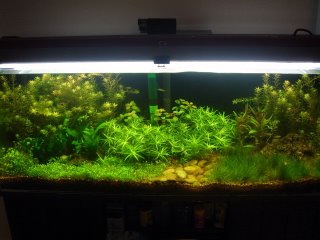
- pH: 6.8
- Temp: 74-76
- KH: 5
- GH:
- NH4:
- NO2:
- NO3: 5
- PO4: 0.2-0.5 (before dosing)
- Iron:
- Dosing: 5 mL Flourish, 20 mL iron chelate (2 ppm), 15 mL KH2PO4 (0.45 ppm)
Notes:
50% morning water change:
3 tsp Equilibrium
2.5 tsp baking soda
0.5 tsp epsom salts
20 mL Amquel+
I also mixed up more nitrate and phosphate solutions:
0.5 tsp KH2PO4 in 250 mL tap water: 5 mL = 0.15 ppm PO4
3.5 tsp KNO3 in 250 mL tap water: 5 mL = 1 ppm NO3
I cleaned out the eheim filter, which was pretty clogged up. Afterwards, the flow rate increased, which caused the eheim surface suction extractor to start a slightly annoying knocking sound. The suction filter has a flow valve which starts rattling with higher flow rate. The manual recommends getting an optional t-junction which divides the flow between the extractor and the original filter intake for filter models 2215 and higher. You can turn on and off the suction action, so when it's turned on, the rattling stops since the flow is divided between the suction and the bottom filter intake.
Upping the iron dosing
- pH: 6.8 morning
- Temp:
- KH:
- GH:
- NH4:
- NO2:
- NO3:
- PO4:
- Iron:
- Dosing: 5 mL Flourish, 20 mL iron chelate (2 ppm)
Notes:
The stargrass (Heteranthera zosterifolia) is still growing in a bit palely. I've upped the iron dosing even more to see if it has even more effect. The iron chelate seems to work equally as well as the iron gluconate (e.g. Flourish Iron), if not better. And since it's much cheaper, I would definitely prefer to use the chelate from now on.
Thursday, February 16, 2006
Ludwigia glandulosa
- pH: 6.7 morning, 6.9 evening
- Temp:
- KH:
- GH: 7
- NH4:
- NO2:
- NO3: 5-10 (color almost 10)
- PO4: 0.75
- Iron:
- Dosing: 5 mL Flourish, 15 mL iron chelate (1.5 ppm)
Notes:
 The new leaves are growing in nice and red on the Ludwigia glandulosa that I got last week. The older leaves are green on top, and red on the bottom side. In the picture, you can see the fuzz/beard algae problem I've been having this week, probably due to the problem of low CO2 levels over the past several days. It might have also come in attached to the new plants I received last week. You can also see the white roots growing from the nodes.
The new leaves are growing in nice and red on the Ludwigia glandulosa that I got last week. The older leaves are green on top, and red on the bottom side. In the picture, you can see the fuzz/beard algae problem I've been having this week, probably due to the problem of low CO2 levels over the past several days. It might have also come in attached to the new plants I received last week. You can also see the white roots growing from the nodes.I've noticed that the otos and SAEs don't seem interested in eating the zucchini anymore, probably because there's enough algae now for them to eat :-). I've even seen one of the angel fish nibbling at the beard algae.
